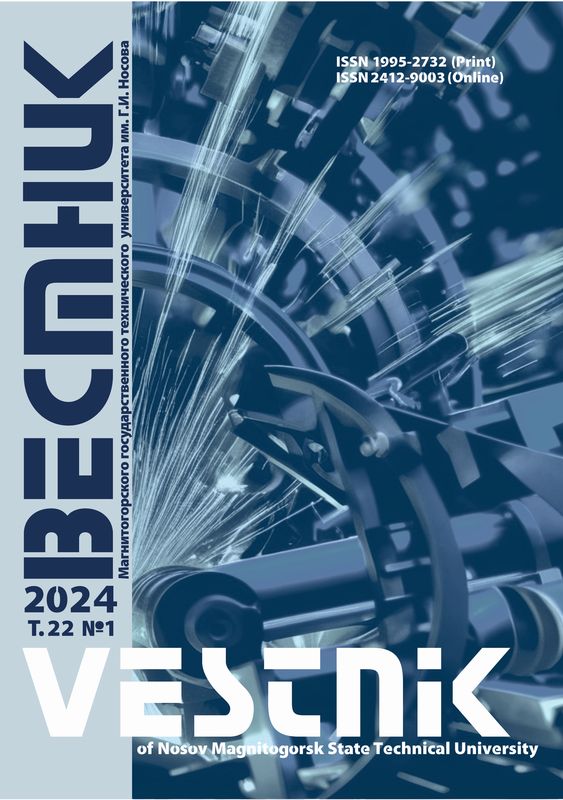DOI: 10.18503/1995-2732-2022-20-2-91-97
Abstract
Problem Statement (Relevance).The paper substantiates the relevance of studying the influence of accelerated cooling modes on the structure formation and properties of steel. Objective.Study on the influence of end temperature of accelerated cooling on the microstructure and properties of low-alloy steel coils. Methods Applied. The laboratory complex LLC Engineering Center Termodeform-NMSTU was used to carry out the physical modeling and study on the processes of melting and thermomechanical treatment of steel of a chemical composition (0.05–0.15)C – (0.10–0.50)Si – (0.7–1.65)Mn, alloyed with Cr, Ni, Cu and Mo. The authors applied 6 modes of thermomechanical treatment of the laboratory samples, differing in the end temperatures of accelerated cooling in the range of 450–650°C. Tensile tests were carried out, applying a universal testing machine, AG-AC 300 by Shimadzu, as well as ZWICK Z2000 series by Zwick GmbH & Co. A complex of metallographic studies was performed using a Meiji Techno optical microscope, using a Thixomet PRO computer image analysis system. The microstructure was studied by scanning electron microscopy, using JEOL JSM-6490LV. Results. It is shown that relatively high temperatures at the end of accelerated cooling (650°C) contribute to forming a structure, consisting of globular bainite with a second phase of ferrite of different morphology. Such a structure ensures the lowest yield strength of steel. Temperatures in the range of 550–600°C are optimal for the end of accelerated cooling, ensuring the formation of grains of acicular bainite and an increase in strength, while maintaining the plastic characteristics of steel. A decrease in the temperature at the end of accelerated cooling to 450°C may be accompanied by the formation of areas with a martensitic component, showing increased hardness. This causes a further increase in strength with a simultaneous decrease in plasticity of the laboratory samples of rolled products.
Keywords
steel, coils, controlled rolling, accelerated cooling, microstructure, mechanical properties.
For citation
Poletskov P.P., Alekseev D.Yu., Kuznetsova A.S., Gulin A.E., Emaleeva D.G. Study on the Influence of Accelerated Cooling Modes on the Structure Formation and Properties of Coils.Vestnik Magnitogorskogo Gosudarstvennogo Tekhnicheskogo Universiteta im. G.I. Nosova [Vestnik of Nosov Magnitogorsk State Technical University]. 2022, vol. 20, no. 2, pp. 91–97. https://doi.org/10.18503/1995-2732-2022-20-2-91-97
1. Nastich S.Yu. Razrabotka tekhnologii termomekhanicheskoy obrabotki polosovogo i listovogo prokata iz nizkolegirovannoy stali na osnove upravleniya formirovaniem ferritno-beynitnoy struktury: dis. d-ra tekhn. nauk [Development of a thermomechanical treatment technology for low-alloy steel strip and sheet products by controlling the formation of a ferrite-bainite structure: Doctoral thesis]. Moscow, 2013. 399 p.
2. Efron L.I. Metallovedenie v «bolshoy» metallurgii. Trubnye stali [Metal science in "big" metallurgy. Pipe steels]. Moscow: Metallurgizdat, 2012, 696 p. (In Russ.)
3. Poletskov P.P., Gushchina M.S., Alekseev D.Yu., Emaleeva D.G., Kuznetsova A.S., Nikitenko O.A. Understanding the effect of controlled rolling regimes for pipe steel on the structural condition of hot-deformed austenite. Vestnik Magnitogorskogo gosudarstvennogo tekhnicheskogo universiteta im. G.I. Nosova [Vestnik of Nosov Magnitogorsk State Technical University], 2018, vol. 16, no. 3, pp. 67–77. (In Russ.)
4. Bershtein M.L., Zaimovsky V.A., Kaputkina L.M. Termomekhanicheskaya obrabotka stali [Thermomechanical treatment of steel]. Moscow: Metallurgiya, 1983, 480 p. (In Russ.)
5. Pickering F.B. High-strength, low-alloy steels – a decade of progress. Microalloying 75: proceedings of aninternational symposiumonhigh-strength, low-alloy steels. N.Y.: Union Сarbide Corp, 1977, pp. 9–31.
6. Salganik V.M., Denisov S.V., Poletskov P.P., Stekanov P.A., Berezhnaya G.A., Alekseev D.Yu. Physical modeling of production processes of hot-rolled plates with a unique set of properties. Vestnik Magnitogorskogo gosudarstvennogo tekhnicheskogo universiteta im. G.I. Nosova [Vestnik of Nosov Magnitogorsk State Technical University], 2014, no. 3 (47), pp. 37–39. (In Russ.)
7. Salganik V.M., Poletskov P.P., Artamonova M.O., Denisov S.V., Chikishev D.N. Termodeform Research and Production Complex for developing new technologies. Stal [Steel], 2014, no. 4, pp. 104–107. (In Russ.)
8. Salganik V.M., Poletskov P.P., Chikishev D.N., Denisov S.V., Stekanov P.A. Laboratory complex for modeling technological processes of plate rolling. Metallurg [Metallurgist], 2014, no. 10, pp. 81–84. (In Russ.)
9. Poletskov P.P., Nikitenko O.A., Kuznetsova A.S., Alekseev D.Yu. Development of heat treatment modes for novel structural sparingly alloyed high-strength steel for Arctic and Far North applications. Metal Science and Heat Treatment, 2021, vol. 63, no. 3–4, pp. 171–177.
10. Poletskov P.P., Kuznetsova A.S., Nikitenko O.A., Alekseev D.Yu. The study of influence of heat treatment procedures on structure and properties of the new high-strength steel with increased cold resistance. CIS Iron and Steel Review, 2020, vol. 20, pp. 50–54.
11. Koptseva N.V., Chukin M.V., Nikitenko O.A. Use of the Thixomet Pro software for quantitative analysis of the ultrafine-grain structure of low-and medium-carbon steels subjected to equal channel angular pressing. Metal Science and Heat Treatment, 2012, vol. 54, no. 7–8, pp. 387–392.
12. State standard GOST 9013-59. Metals. Methods for measuring Rockwell hardness. Moscow: Standards Publishing House, 2001, 10 p. (In Russ.)












